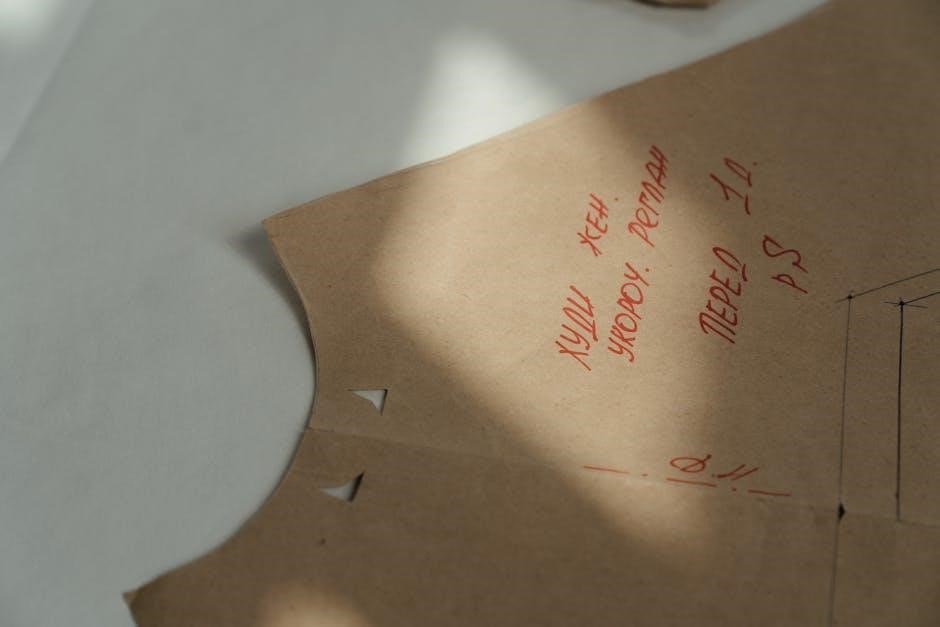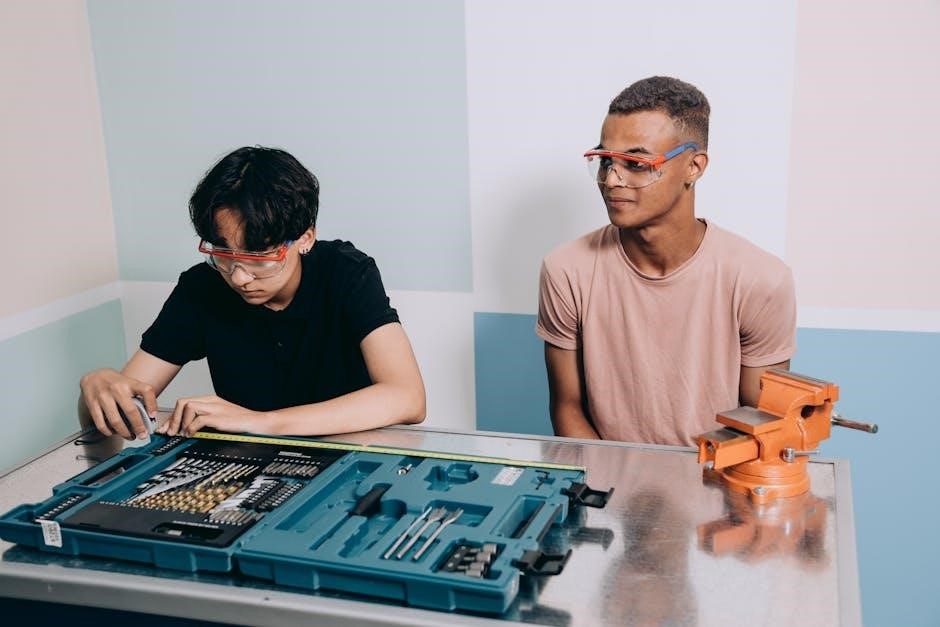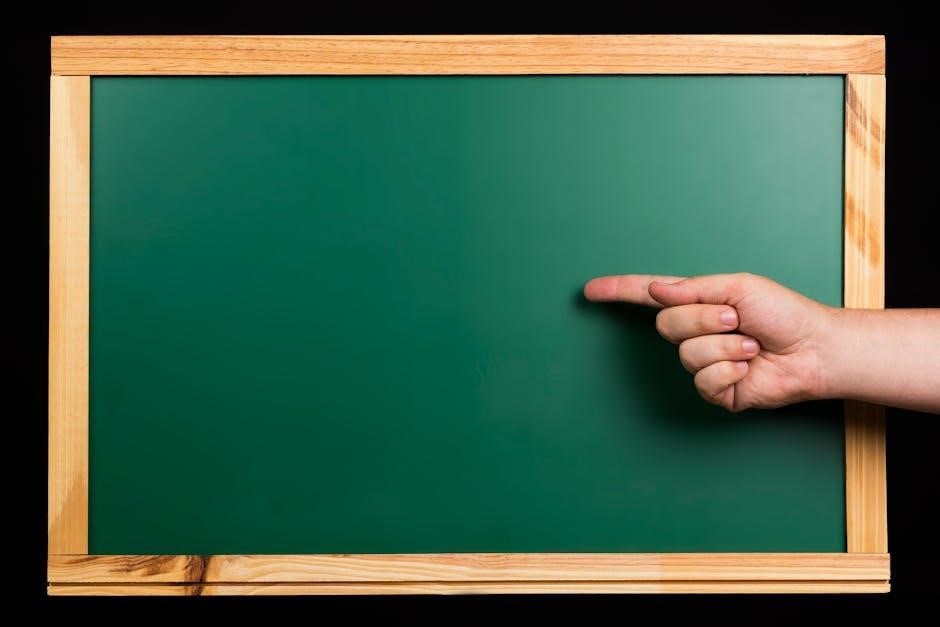
Welcome to the Singer 2517C Instruction Manual. This comprehensive guide covers setup, operation, maintenance, and troubleshooting. Available in English, French, and Spanish, it ensures seamless sewing experiences for all users.
1.1 Overview of the Singer 2517C Sewing Machine
The Singer 2517C is a versatile sewing machine designed for a variety of sewing projects. It features multiple stitch options, including straight and zigzag stitches, and is equipped with a range of practical functions. The machine is user-friendly, making it suitable for both beginners and experienced sewists. With its durable construction and advanced features, the Singer 2517C offers reliable performance for crafting, repairing, and creating custom designs. This machine also comes with essential accessories, ensuring a seamless sewing experience.
1.2 Importance of Reading the Manual
Reading the Singer 2517C manual is essential for maximizing the machine’s potential and ensuring safe operation. It provides detailed instructions for setup, troubleshooting, and maintenance, helping users avoid common issues. The manual also outlines safety precautions and offers tips for customizing stitches and using accessories effectively. By following the guide, users can optimize their sewing experience, achieve professional results, and extend the machine’s lifespan. Whether you’re a beginner or an experienced sewist, the manual serves as an invaluable resource for mastering the Singer 2517C.
1.3 Structure of the Manual
The Singer 2517C manual is organized into clear, logical sections to guide users through setup, operation, and maintenance. It begins with an introduction, followed by detailed explanations of machine features, basic operations, and advanced techniques. The manual also includes troubleshooting, maintenance tips, and safety precautions. Each section is divided into subheadings for easy navigation, ensuring users can quickly find specific information. The structured format allows sewists of all skill levels to understand and utilize the machine’s full potential effectively.

Understanding the Machine’s Features
The Singer 2517C offers versatile stitching options, automatic features, and included accessories, making it a user-friendly machine for various sewing projects.
2.1 Physical Components of the Singer 2517C
The Singer 2517C features a durable design with a metal frame, ensuring stability during operation. Key components include the sewing head, free arm, and bobbin compartment. The stitch selector dial, thread tension dials, and presser foot lever are easily accessible. The machine also includes a built-in carry handle for portability. Additional features like the reverse stitch lever and stitch length adjustment knob enhance functionality. Understanding these components is essential for effective operation and troubleshooting.
2.2 Stitch Options and Customization
The Singer 2517C offers a variety of stitch options, including straight, zigzag, and decorative stitches, totaling 17 built-in stitches. Users can customize stitch length and width using the adjustment dials. The machine allows for reverse stitching to secure seams. Additional customization includes adjusting thread tension for different fabrics and using the free arm for sewing cuffs or sleeves. The presser foot lever enables easy fabric control, making it versatile for various sewing projects. These features provide flexibility for both basic and creative sewing tasks.
2.3 Accessories Included with the Machine
The Singer 2517C comes with a variety of accessories to enhance your sewing experience. These include a set of presser feet, such as the general-purpose foot, zipper foot, and buttonhole foot. Additional accessories consist of bobbins, a seam ripper, and a pack of needles. A soft dust cover is also provided to protect the machine when not in use. An instructional DVD is included, offering step-by-step guidance for getting started. These accessories ensure you have everything needed to begin sewing various projects right away.

Setting Up the Machine
Setting up the Singer 2517C involves unpacking, placing it on a stable surface, and ensuring all components are securely attached. Plug in the machine and prepare for use.
3.1 Unpacking and Initial Inspection
Begin by carefully unpacking the Singer 2517C sewing machine from its box. Inspect the machine and accessories for any visible damage or missing parts. Verify that all components, such as the power cord, presser feet, and bobbin, are included. Gently remove any protective packaging materials and ensure the machine is placed on a stable, flat surface. Before use, visually inspect the machine for loose parts or damage. Refer to the manual for a list of included accessories and ensure everything is accounted for. This step ensures a smooth setup process.
3.2 Threading the Machine
To thread the Singer 2517C, start by placing the thread spool on the spool pin. Gently pull the thread through the first guide, then loop it around the tension discs. Next, guide the thread through the take-up lever and finally through the needle. Use the built-in needle threader for easier threading. Ensure the thread is not tangled or twisted. After threading, pull gently to check for slack; Proper threading ensures smooth stitching and prevents issues during sewing. Always refer to the manual for specific threading diagrams if unsure.
3.3 Winding and Installing the Bobbin
To wind the bobbin, place it on the bobbin winder and pull the thread through the guide. Hold the thread gently and press the foot pedal to wind. Stop when the bobbin is about 80% full. Remove it and cut the thread. To install, open the bobbin case, insert the bobbin, and pull the thread through the slot. Close the case and pull the thread to seat the bobbin properly. Ensure the thread is not tangled and the bobbin is evenly wound for smooth stitching. Always use the correct bobbin size for optimal performance.

Basic Operation of the Singer 2517C
This section covers the Singer 2517C’s basic operation, including selecting stitches, adjusting thread tension, and controlling the machine’s start/stop functions for smooth sewing experiences.
4.1 Selecting the Right Stitch Type
The Singer 2517C offers a variety of stitches for different sewing tasks. Choose from straight, zigzag, and decorative stitches based on fabric type and project requirements. For heavy fabrics, use the straight stitch, while stretchy materials benefit from the zigzag stitch. Decorative stitches add aesthetic appeal to your work. Use the stitch selector dial or buttons to easily switch between options. Always test the stitch on scrap fabric before sewing your final project to ensure the best results. Proper stitch selection enhances both functionality and creativity in your sewing projects.
4.2 Adjusting Thread Tension
Proper thread tension ensures even stitching and prevents fabric puckering. Adjust the upper thread tension by turning the dial located on the front of the machine; For the bobbin thread, adjust the small screw on the bobbin case. Start with the factory-recommended settings, then fine-tune as needed. Test stitches on scrap fabric before sewing your project. Avoid over-tightening, as it can damage the machine or cause thread breakage. Correct tension results in balanced stitches, improving the overall quality of your sewing projects.
4.3 Starting and Stopping the Machine

To start the Singer 2517C, ensure the machine is properly threaded and the power switch is turned on. Use the foot pedal to control sewing speed, applying gentle pressure for smooth operation. To stop, gradually reduce pedal pressure and allow the machine to complete its current stitch. Turn off the power switch and unplug the machine when not in use. Always ensure the needle is in its highest position before stopping. This ensures safety and prevents accidental needle breakage or fabric damage. Proper stopping helps maintain machine longevity and user safety.

Advanced Sewing Techniques
Explore advanced sewing methods like decorative stitching, precision quilting, and intricate embroidery. Master techniques for smooth fabric control and professional-grade finishes using the Singer 2517C’s versatile features.
5.1 Sewing Straight Stitches
The Singer 2517C makes sewing straight stitches effortless. Begin by selecting the straight stitch option, typically marked as stitch #1. Ensure the machine is properly threaded and the bobbin is installed correctly. Place your fabric under the presser foot, aligning the edge with the guide. Gently pull the fabric to maintain tautness and start sewing at a steady pace. Use the handwheel for precise control when necessary. Straight stitches are ideal for seaming, repairs, and creating straight lines in your projects. Always keep the fabric moving smoothly to achieve consistent results.
5.2 Sewing Zigzag Stitches
To sew zigzag stitches on the Singer 2517C, select the zigzag stitch option, usually marked as stitch #2. Ensure the machine is threaded correctly and the fabric is placed under the presser foot. Adjust the stitch length and width according to your preference using the control dials. Begin sewing at a steady pace, keeping the fabric moving smoothly. Zigzag stitches are perfect for finishing raw edges, preventing fraying, or adding decorative touches. Maintain consistent fabric tension for even stitching. Use the handwheel for precise control when needed. This versatile stitch enhances both functional and creative sewing projects.
5.3 Creating Buttonholes
To create buttonholes with the Singer 2517C, select the automatic buttonhole stitch. Use the buttonhole foot for precise results. Place the fabric under the foot, aligning the edge. Sew a test buttonhole on scrap fabric to ensure accuracy. Position the button on the fabric where desired and sew. The machine will create a perfect buttonhole. Adjust settings if needed for larger or smaller buttons. Cut the buttonhole carefully with scissors or a seam ripper. This feature ensures professional-looking buttonholes for garments and projects.

Maintenance and Care
Regular maintenance ensures optimal performance and extends the lifespan of the Singer 2517C. Clean, oil, and inspect the machine frequently to prevent dust buildup and friction.
6.1 Cleaning the Machine
Regular cleaning is essential to maintain the Singer 2517C’s performance. Turn off and unplug the machine before cleaning. Use a soft brush to remove dust and lint from the bobbin area, tension discs, and stitch plate. Avoid harsh chemicals or abrasives, as they may damage the machine’s finish. Compressed air can be used to gently remove debris. Clean the exterior with a damp cloth. Regular cleaning prevents dust buildup and ensures smooth operation. Always refer to the manual for specific cleaning instructions to avoid damage.
6.2 Oiling the Machine
Regular oiling is crucial for the smooth operation of the Singer 2517C. Use high-quality sewing machine oil, applied to the hook race and other moving parts as indicated in the manual. Oil the machine after every 8-10 hours of use or when you notice increased friction. Avoid over-oiling, as it can attract dust. Turn the handwheel to distribute the oil evenly. Proper lubrication prevents wear and tear, ensuring the machine runs quietly and efficiently. Always unplug the machine before oiling for safety.
6;3 Regular Maintenance Check-Ups
Perform regular maintenance check-ups to ensure optimal performance of the Singer 2517C. Inspect for dust and lint buildup, especially around the bobbin area and tension discs. Use a soft brush or cloth to clean these parts. Check the belt and machine feet for wear or damage. Ensure the needle is sharp and replace it every 8 hours of use. Always unplug the machine before performing maintenance. Regular check-ups help prevent mechanical issues and maintain sewing accuracy. Schedule these inspections every 1-2 months, depending on usage frequency.

Troubleshooting Common Issues
Troubleshooting helps resolve issues like thread breakage, bobbin problems, or machine noise. Identify symptoms, adjust settings, and consult the manual for solutions. If issues persist, contact support.
7.1 Thread Breakage
Thread breakage on the Singer 2517C can be caused by improper threading, low-quality thread, or a dull needle. Check thread guides, ensure proper tension, and replace the needle if necessary. Adjust the take-up lever and consider using a thread conditioner. If issues persist, consult the manual or contact Singer support for further assistance.
7.2 Bobbin Issues
Bobbin issues, such as improper winding or incorrect installation, can disrupt stitching. Ensure the bobbin is wound evenly and not overfilled. Check if the bobbin is seated correctly in the bobbin case, with the thread pulling smoothly. If the bobbin case is misaligned, adjust it gently. Regularly clean lint from the bobbin area to prevent jams. Refer to the manual for specific guidance on bobbin maintenance and troubleshooting to resolve issues effectively.
7.3 Machine Noise or Jams
Machine noise or jams can occur due to improper threading, lint buildup, or incorrect stitch settings. To resolve, turn off the machine and unplug it. Gently remove any tangled thread or debris from the needle area and bobbin compartment. Check for loose screws or misaligned parts. Regular cleaning and oiling, as outlined in the manual, can prevent such issues. If the problem persists, consult the troubleshooting section or contact Singer support for assistance.

Customization and Accessories
Explore various accessories like presser feet, extension tables, and optional add-ons to enhance your sewing experience with the Singer 2517C. Customize your machine to suit your projects and preferences for optimal results.
8.1 Using Different Presser Feet
The Singer 2517C allows for enhanced sewing versatility by using specialized presser feet. The all-purpose foot is ideal for straight stitching, while the zipper foot simplifies adding zippers. The blind hem foot is perfect for invisible hems, and the buttonhole foot guides precise buttonhole creation. Attach the desired foot by snapping it onto the shank, ensuring it’s secure. Always match the presser foot to your fabric type and stitch selection for optimal results. Experimenting with different feet can expand your sewing capabilities and improve stitch quality.
8.2 Upgrading or Replacing Parts
Upgrading or replacing parts on the Singer 2517C can enhance performance and extend its lifespan. Always use genuine Singer parts to ensure compatibility and maintain warranty validity. Common upgrades include the sewing machine motor, tension discs, or the bobbin case. To replace parts, refer to the manual for disassembly instructions. Use the correct tools to avoid damaging the machine. For complex replacements, consult a professional or Singer-authorized service center. Regularly inspecting and replacing worn parts prevents operational issues and ensures smooth sewing experiences.
8.3 Optional Accessories for Enhanced Sewing
Enhance your sewing experience with optional accessories designed for the Singer 2517C. These include specialized presser feet, such as zipper, walking, and blind hem feet, to tackle various sewing tasks. An extension table provides extra workspace for larger projects. Additional bobbin cases and specialty threads, like metallic or heavy-duty options, expand your creative possibilities. Custom storage cases or covers protect your machine and keep accessories organized. These accessories are available through Singer or authorized retailers, ensuring compatibility and quality for optimal performance.

Safety Precautions
Ensure safe operation by keeping the machine away from children, using it on a stable surface, and avoiding water exposure. Proper handling of needles and threads is essential for preventing accidents.
9.1 General Safety Tips
Always maintain a safe environment while using the Singer 2517C. Keep the machine out of children’s reach and ensure it is placed on a stable, flat surface. Avoid exposing the machine to water or moisture to prevent electrical hazards. Use the machine in a well-ventilated area, away from flammable materials. Never touch sharp parts like needles or cutters with bare hands. Keep loose clothing and long hair tied back to avoid entanglement. Regularly inspect the machine for damage and ensure all parts are securely attached before use. Follow all safety guidelines provided in the manual to ensure safe and efficient operation.
9.2 Electrical Safety
Ensure the Singer 2517C is used with the correct power source as specified in the manual. Avoid exposing the machine to water or moisture, as this can cause electrical shocks. Never operate the machine with damaged cords or plugs. Keep the power cord away from hot surfaces or sharp objects. Unplug the machine when not in use or during maintenance. Avoid overloading electrical outlets. If repairs are needed, consult a qualified technician to prevent electrical hazards. Always follow the manufacturer’s guidelines for safe operation.
9.3 Avoiding Accidents
Always keep fingers away from the needle and presser foot area while sewing. Use the provided presser foot to guide fabric, never your hands. Tie back long hair and avoid loose clothing that could get caught. Ensure the work area is clear of clutter and well-lit. Keep children and pets away while operating the machine. Avoid sewing when tired or under the influence of medication. Never leave the machine unattended while it is in operation. Regularly inspect for worn or loose parts to prevent accidental mishaps.
Accessing the Singer 2517C Manual
Access the Singer 2517C manual on Singer’s official website. Available in English, French, and Spanish. Download, save, or print for easy reference and troubleshooting guide.
10.1 Downloading the PDF Manual
To download the Singer 2517C instruction manual, visit Singer’s official website and navigate to the “Support” or “Manuals” section. Search for the Singer 2517C model, select the correct option, and choose your preferred language. Click the download link to save the PDF file to your device. Ensure you download the latest version for accurate and updated information. This digital format allows easy access and reference, enabling you to zoom in for details or print specific pages as needed. Always verify the source to avoid unauthorized or outdated versions.
10.2 Language Options (English, French, Spanish)
The Singer 2517C instruction manual is available in multiple languages, including English, French, and Spanish. This ensures accessibility for users across different regions. To access the manual in your preferred language, visit Singer’s official website and select the appropriate language option from the dropdown menu or language selector. Additionally, Singer’s authorized dealers may provide multilingual manuals upon request. This feature allows users to understand the machine’s features and operations clearly, regardless of their primary language. Ensure to select the correct language version for accurate guidance tailored to your needs.
10.3 Printing the Manual
To print the Singer 2517C instruction manual, first ensure you have access to the PDF version. Save the file to your device and open it using a PDF reader. Use a standard printer with A4 or letter-sized paper for optimal results. For clarity, print in color if possible. Consider binding the pages for easy reference. Double-check your printer settings to avoid scaling issues. Always print from the official Singer website or authorized sources to ensure accuracy. Printing the manual provides a handy physical guide for quick access during sewing projects.
11.1 Summary of Key Points
The Singer 2517C instruction manual provides a comprehensive guide to understanding and optimizing your sewing machine. It covers machine features, setup, operation, and maintenance, ensuring you master basic and advanced techniques. The manual emphasizes safety, troubleshooting, and customization, offering practical advice for seamless sewing experiences. By following the outlined steps and tips, you’ll be well-equipped to tackle various projects with confidence and creativity. Regular practice and proper care will extend the life of your machine and enhance your sewing results.
11.2 Encouragement to Practice
Practice is key to mastering the Singer 2517C sewing machine. Regular use helps build confidence and creativity, allowing you to explore various stitching techniques and projects. Start with simple tasks like straight lines or zigzag patterns, gradually progressing to more complex designs. Troubleshooting becomes easier with familiarity, ensuring smooth sewing experiences. Dedicate time to experiment and refine your skills—consistent practice will enhance your proficiency and unlock the full potential of your Singer 2517C. Enjoy the journey of learning and creating!